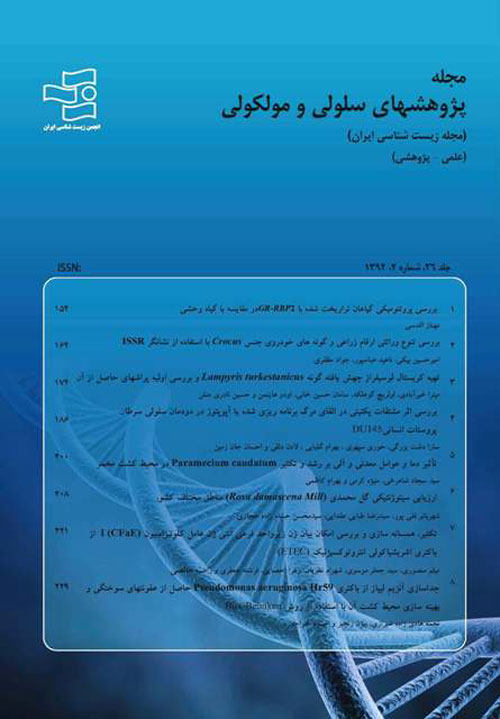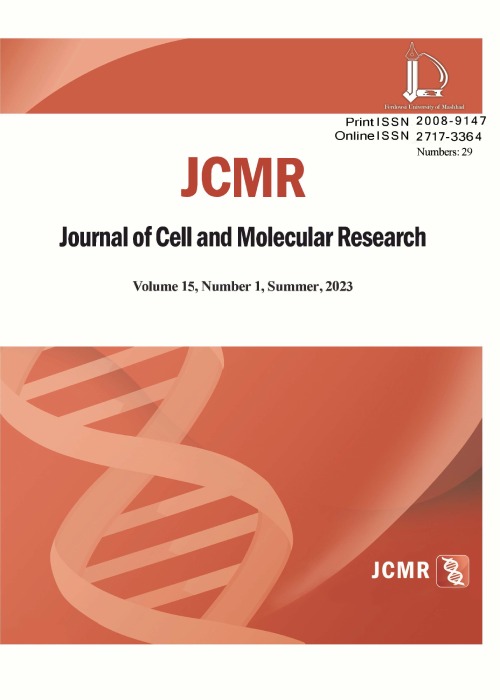فهرست مطالب

Journal of Cell and Molecular Research
Volume:6 Issue: 2, Winter and Spring 2014
- تاریخ انتشار: 1393/09/24
- تعداد عناوین: 10
-
-
Pages 50-51Pluripotency is a central feature of stem and cancer cells. This feature enables cancer cells to self-renew and trans-differentiate. In this editorial, it is hypothesized that in cancer cells synchronized events rather than segmented procedures may lead to pluripotency.Keywords: Pluripotency, Stem cells, Cancer cells
-
Pages 52-56MicroRNAs constitute a group of small non-coding RNAs that negatively regulate gene expression. Aside from their contribution to biological and pathological pathways, altered expression of microRNAs is reported in bio-fluid samples, such as serum. To employ serum''s microRNAs as potential biomarkers, it is crucial to develop an efficient method for microRNA quantification, avoiding pre-analytical and analytical variations which could affect the accuracy of data analysis. Here, we optimized a real-time PCR quantification procedure for microRNA detection in serum samples. Serum''s total RNA was extracted using two different RNA isolation methods, one based on phenol-chloroform and the other based on silica column. To investigate a potential PCR inhibitory effect, different RNA amounts were subjected to reverse transcription. Moreover to assess the enzymatic efficiency, synthetic exogenous microRNAs was spiked into the mixture. Moreover, to find a reliable internal control gene for normalizing the microRNA quantification, the amounts of 8 candidate non-coding RNAs including SNORD38B, SNORD49A, U6, 5S rRNA, miR-423-5p, miR-191, miR-16 and miR-103 were assessed on serum samples. Altogether, our data demonstrated that the silica-based method was more efficient for microRNA recovery. Furthermore, increasing the input volume of the extracted RNA would dramatically increase inhibitors'' amounts which could end up in a larger Cq values. Therefore, the best input volume of RNA turned out to be 1.5 microliter/reaction. Among the 8 aforementioned internal controls, U6, SNORD38B and SNORD49A showed low levels of expression, and were undetectable in some samples. Amongst the others, 5s rRNA, had the biggest standard deviation which could significantly affect data analysis. MiR-103 with the least variation appeared to be the best normalizer gene.Keywords: MicroRNA recovery, Real, time PCR quantification, Normalizer gene
-
Pages 57-63Microglia cells are a subset of central nervous system (CNS) macrophages. Changes in the CNS such as injury, or developmental events, follow by morphological and physiological changes in microglia cells. In this study organotypic brain slice cultures under serum free condition were used to investigate the morphology and lectin histochemistry of microglia and macrophages in the CNS in vitro. Microglial cells exhibited dramatic morphological changes in the organotypic brain slice culture. Immediately after slicing microglias were seen to have the same morphology as they do in the intact brain: they had small cell bodies from which radiated several highly ramified processes. After 1 day in vitro all microglia transformed into an active form with round soma and no processes. At 5 days in vitro, and especially at 9 days in vitro, many of the microglia had tended to return to the ramified phenotype. The expression of different carbohydrates was examined at the 0, 1, 5 and 9 days in vitro time periods by employing Lycopersicon esculentum tomato lectin (LEL lectins) and Sambucus nigra (SNA). Microglial cells with different morphology intensely stained with LEA. SNA stained the ramified microglia only after they re-ramified at 5 DIV and 9 DIV. The results of this study confirmed that the expression of carbohydrate structures in these cells would undergo changes commensurate with the changes in morphology.Keywords: Microglia, Macrophage, Phagocyte, Lectin, in vitro
-
Pages 64-68Schizophrenia is a sophisticated mental disability which has affected nearly1.1% of people all over the world. According to recent researches, the key proteins triggered in the immune system are cytokines which might also be taking part in the pathogenesis of schizophrenia. The aim of this study was to evaluate the relationship between the -1082G/A and +874T/A polymorphisms of IL-10 and IFN-γ genes, respectively, in patients with schizophrenia.Materials And MethodsTotal of 94 schizophrenic patients and 97 individuals as control samples were enrolled in this study. All samples were genotyped by amplification mutation refractory system-polymerase chain reaction (ARMS PCR) for candidate SNPs in IFN-γ and IL-10 genes.ResultsNo significant association was found among various genotypes of IFN-γ and IL-10 in selected SNPs with risk of schizophrenia, As well as there was no significant variation in allelic frequency of IFN-γ and IL-10 genes with the risk of disease.ConclusionThese data suggest that the -1082G/A of IL-10 and +874T/A IFNγ genes are not involved in the development of schizophrenia risk. To validate of this data, suggesting more studies in diverse populations with larger sample size.Keywords: Schizophrenia, IFN, γ IL, 10, gene, polymorphism
-
Pages 69-75Gene delivery might be affected by several tribulations based on carrier/vector applied. Bacteriophages lambda and M13 have different genome conformations; linear double-stranded and circular single-stranded respectively. Therefore, it might be expected that these two common classes of gene delivery vehicles will have different capacity for gene delivery and expression in eukaryote cells. To address the possible effects of linear double-stranded and circular single-stranded genome conformations of bacteriophages lambda and M13 on the transgene expression, the transfection efficacy of two vectors based on lambda and M13 were compared in AGS cell line. The GFP encoding sequence was inserted into the Lambda ZAP-CMV XR vector which resulted in λ-ZAP-CMV-GFP construct. The construct was then in vitro packaged using Gigapack® III Gold packaging extract and λ-GFP phage particles were obtained. The λ-GFP phage particles were then used for in vivo excisioning which resulted in M13-CMV-Script-GFP construct. 1011 copy of λ-ZAP-CMV-GFP or M13-CMV-Script-GFP constructs were transfected into AGS cells using lipofectamine 2000. Transfection efficiencies were analyzed by FACS. Results showed that linear double-stranded λ-ZAP-CMV-GFP was efficient than single-stranded form of M13-CMV-Script-GFP while its double-stranded form was efficient than the linear double-stranded λ-ZAP-CMV-GFP construct for transgene delivery and expression. Moreover the GFP signals resulted from transfections by single-stranded form of M13-CMV-Script-GFP construct faded more quickly in comparison to others. These findings highlight that genome conformation of gene carriers might be an important factor when seeking for an appropriate gene carrier/vehicle.Keywords: gene delivery, phage, mediated gene transfection, vector conformation
-
Pages 76-82BackgroundAmniotic membrane derived stem cells (AMSCs) have considerable advantages to use in regenerative medicine and their anti- inflammatory effects, growth factor secretion and differentiation potential make them suitable candidates for stem cell therapy of nervous system. The developing and neonatal brain contains a spectrum of growth factors to direct development of endogenous and donor cells. Using an in vitro model system, we investigated the plasticity and potential of mouse AMSCs to differentiate into neural cells in response to neonatal mice brain extracted medium.MethodsMouse amniotic membrane stem cells were isolated from embryos, cultured in presence of medium derived from neonatal mouse brain medium and immunohistochemistry and flow cytometry analyses were used to explore the neural differentiation of them.ResultsIsolated amnion membrane stem cells showed high rate of viability and proliferation and presented neural characters in the presence of neonatal brain extracted medium such morphological changes and Nestin and Map-2 expression.ConclusionIn conclusion, results from this study showed that amnion membrane derives stem cells are potent stem cells to respond to environmental signals promoting them to neural fate.Keywords: Brain Extract, Amniotic Membrane Derived Stem Cells, Neural Differentiation, Amnion Membrane, In Vitro Model System
-
Pages 83-92In present study, a SYBR green based real time PCR assay was developed for specific detection and quantification of Bacillus subtilis in dough used for bread making. New primer pairs were designed to amplify a 212 base pair fragment of the aprE gene. Specificity of these primer pairs was confirmed with conventional and real time PCR methods. Standard curves constructed using the threshold cycle (CT) versus copy numbers of B. subtilis showed good linearity for reference standards of cloned insert (R2=0.999, slope=-3.035) and also induced contaminated dough (R2=0.988, slope=-3.142), and the melting temperature (Tm=82.2 oC) was consistently specific for the amplicon. Limits of detection were 200 and 2000 colony forming units (CFUs) per ml or g of these samples, respectively. This real time PCR offers a fast tool with high sensitivity and specificity for detection and quantification of this rope-forming pathogen in dough used for bread making.Keywords: Real time PCR, Bacillus subtilis, New primer pairs, Contaminated dough
-
Pages 93-98In this study, we examined the chromosome number, detailed male meiosis, microsporogenesis, pollen fertility and distribution of cytotypes of Diplotaxis harra (Forssk.) Boiss. This is the first cytogenetic report of the taxon. The two of the populations scored now from regions of the central showed aneuploid (x = 14) meiotic chromosome count and one of the populations studied from the existed at the diploid level (x = 13). It seems that the species with x = 14 are derived through aneuploid increase. The most prominent among these meiotic abnormalities was the chromatin stickiness which involved inter PMC and fragmented chromosome at different stages of meiosis. Consequently, these populations exhibited varying percentages of pollen sterility and pollen grains of smaller sizes. The aim of the present research was to study the male meiosis in detail and to find the impact of chromatin stickiness in inducing meiotic aberrations and their consequent effect on pollen fertility and pollen size, also to differentiate the individuals growing wild and also to find out the distribution patterns of different cytotypes in the Iran.Keywords: Brassicaceae, chromosome number, cytotypes, Diplotaxis, Iran, meiotic
-
Pages 99-102Preserving genetic diversity of Iranian native chickens is significant in order to perform breeding programs and improved production. Genetic diversity among close populations can be determined by investigating their phylogenetic relations. Different approaches have been applied to determine the phylogenic relations from which genomic sequencing has been considered the most functional approach. In this project, we aimed to evaluate the phylogeny and genetic nucleotide sequences of ND4, ND4L regions in mitochondrial genome of Khorasan native chickens. Blood samples were collected from randomly 6 Khorasan native chicken populations and DNA were extracted. ND4L, ND4 regions were amplified using specific primers of 913 and 802 bp length, respectively. Sequencing was don according to Sanger method based on automated system. In comparison with other breeds (data extracted from NCBI), phylogeny trees and matrices regarding their genetic diversity with Khorasan native chickens for ND4, ND4L were drawn. Results showed that there is no haplotype difference between the studied samples. Lowest genetic distance was observed between Khorasan native chicken and other Asian chickens i.e. Jiangbian, Lvenwv and Red jungle fowl for the ND4, ND4L genes indicating their close relationship.Keywords: khorasan native chicken, ND4L, ND4, mitochondrial DNA, phylogeny tree
-
Pages 103-104Neural tube defects (NTDs) are complex problem of central nervous system including brain and spinal cord. Anencephaly and myelomeningocele are the two most common forms of NTDs. Epidemiological studies reveal that genetic and environmental factors are responsible for the development of NTDs. During embryogenesis large numbers of extrinsic and intrinsic factors are responsible for the closer of neural tube which is responsible to maintain the three germ layers including neural ectoderm. The role of MTHFR & RFC-1 gene in etiopathology of NTDs has not been clearly defined in Indian population. Hence, the curiosity has been developed with the aim to evaluate folate metabolism and folate regulatory gene in clinically diagnosed NTDs by using PCR based DNA analysis with selected specific forward/reverse primers. Interestingly, the highest frequency (12.5%) of CT has been appeared of MTHFR C677T gene noticed in NTDs mother. We also observed the similar frequency of heterozygous AG genotype in NTDs of A80G RFC-1 gene. Therefore, C and A allele have high prevalence among than other genotype. However, the mutation in MTHFR partially have protective effect of embryo and these selected candidate folate markers are responsible to influence the cells of neural crest confirming the folding of neural tube associated with severity of disease in NTDs.Keywords: NTDs, MTHFR, RFC, 1, Folate, Homocystine


